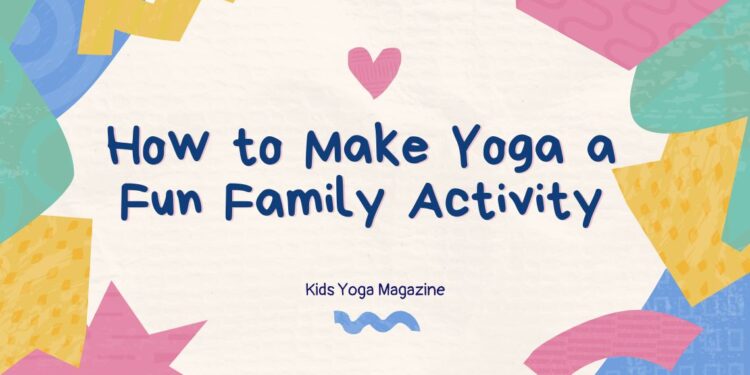Yoga is more than just a physical exercise; it’s an opportunity to connect, relax, and enjoy quality time together as a family. Incorporating yoga into your family routine can be a fun and enriching experience for everyone, regardless of age or fitness level. The key to making yoga a beloved family activity is to keep it engaging, lighthearted, and accessible. Here are some practical tips on how to make yoga a fun family activity that everyone will look forward to.
1. Create a Welcoming Space
Start by creating a comfortable and inviting space where your family can practice yoga together. This could be a corner of your living room, a spot in the backyard, or even a designated room for yoga and relaxation. Lay out yoga mats or soft blankets and add a few cushions or pillows for comfort. To make the space feel special, consider adding calming elements like soft lighting, soothing music, or even some plants. A welcoming environment sets the tone for a peaceful and enjoyable practice.
2. Involve Everyone in the Planning
To get everyone excited about family yoga, involve each family member in the planning process. Let everyone have a say in what kind of yoga session they’d like to try. Maybe one child wants to do an animal-themed yoga session, while another prefers a superhero theme. You can also take turns choosing the yoga poses, music, or even the time of day for the practice. When everyone feels included, they’re more likely to be enthusiastic about participating.
3. Incorporate Themes and Stories
One of the best ways to keep yoga fun for the whole family is to incorporate themes and stories into your sessions. Kids especially love this approach, as it allows them to use their imagination and creativity. For example, you can have a “Safari Adventure” yoga session where you all pretend to be different animals like lions, elephants, and monkeys, with corresponding poses. Or, you can embark on a “Space Mission,” where you do poses that mimic rockets, stars, and planets. Themes and stories turn yoga into a playful activity that feels more like a game than exercise.
4. Use Props and Toys
Props and toys can add an extra layer of fun to your family yoga practice. For younger children, you can use stuffed animals or action figures to demonstrate poses or as “yoga buddies” that accompany them during the session. Yoga blocks, straps, and even pillows can be used creatively to enhance certain poses or make them more accessible. For example, you can have a “tower-building” challenge where you stack yoga blocks as you balance in Tree Pose. These props make the experience more interactive and help keep younger participants engaged.
5. Make It Interactive with Partner Poses
Partner poses are a great way to bring the family together, encouraging teamwork and cooperation. Many yoga poses can be adapted for two or more people, making them more fun and challenging. For example, you can try Double Downward Dog, where one person does Downward-Facing Dog, and another person places their hands on the first person’s lower back and lifts into their own Downward Dog. Or, you can try a Seated Forward Bend where two people sit back-to-back, pressing their feet together as they lean forward. Partner poses help build trust and deepen connections while adding an element of play to the practice.
6. Keep Sessions Short and Sweet
Attention spans can vary, especially with younger children, so it’s important to keep yoga sessions short and sweet. Aim for 15 to 30 minutes, depending on the ages and interests of your family members. This ensures that the practice remains enjoyable and doesn’t become tedious. You can gradually increase the length of your sessions as everyone becomes more comfortable with the practice. The key is to leave everyone feeling refreshed and eager to come back for more, rather than exhausted or bored.
7. Incorporate Games and Challenges
Turning yoga into a game or challenge can make it more engaging for kids (and adults too!). You can create a “Yoga Obstacle Course” where family members move through different poses as they navigate the course. Another idea is a “Yoga Pose Scavenger Hunt,” where you hide yoga pose cards around the house or yard, and everyone has to find and perform the poses. You can also challenge each other to hold certain poses for as long as possible, with a reward for the winner. These games and challenges make yoga feel like playtime, which is a great way to get everyone excited about participating.
8. Use Music to Set the Mood
Music can greatly enhance the atmosphere of your family yoga practice. Choose a playlist that suits the mood you want to create—calming music for a relaxing session, or upbeat tunes for a more energetic practice. You can even incorporate songs that have movement cues or yoga-themed lyrics to guide your session. For example, playing “The Yoga Song” during a session can prompt kids to move through different poses with the music. Music makes the practice more lively and can help keep everyone engaged, especially during longer sessions.
9. End with a Relaxing Family Savasana
After an active yoga session, it’s important to wind down with a relaxing Savasana (Corpse Pose). This is a time for everyone to lie down, close their eyes, and relax. You can guide your family through a short meditation, focusing on deep breathing and letting go of any tension. To make it more enjoyable for kids, you can ask them to imagine they are lying on a fluffy cloud, floating in the sky, or relaxing on a peaceful beach. Ending your practice with a calming Savasana helps everyone transition from activity to rest, leaving them feeling peaceful and content.
10. Celebrate Your Practice Together
Finally, always celebrate your family yoga practice together. Whether it’s by sharing high-fives, talking about your favorite part of the session, or enjoying a healthy snack afterward, it’s important to acknowledge the time you’ve spent together. Positive reinforcement helps everyone associate yoga with good feelings and encourages them to look forward to future sessions. You might even create a family yoga journal where everyone can write or draw their favorite poses and experiences, making it a cherished family activity.
Conclusion
Making yoga a fun family activity is all about creativity, flexibility, and togetherness. By incorporating themes, games, partner poses, and music, you can transform yoga into an enjoyable experience that everyone looks forward to. Remember to keep the sessions lighthearted and focus on the joy of being together, rather than perfection. With these tips, you can create lasting memories and foster a love for yoga that will benefit your family for years to come.












